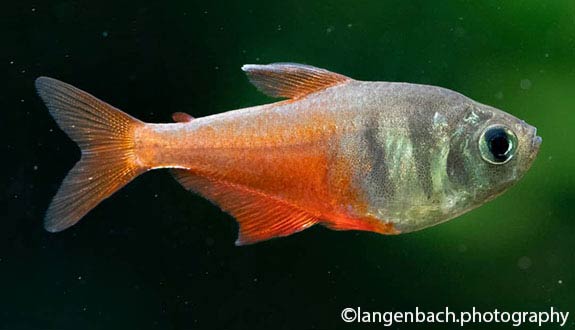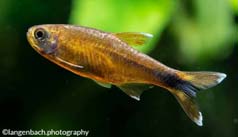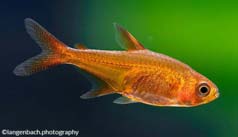

Alternative species (click on the thumbnail to see the card)
Names
Scientific name
Hyphessobrycon flammeus
Common name
Flame tetra
Rio tetra
Von Rio Tetra
Origin

Origin: East of Brazil (Rio de Janeiro)
Biotope: Amazonian
Dimorphism

The female is rounder than the male. The black border of the anal fin is thicker in the male.
Group

Characidae
Volume

80 L / 18 Imp Gal / 21 US Gal
Parameters

T°: 23 to 26°C or 73 to 79°F
pH: 6 to 7
Hardness: 3 to 14°dGH
Difficulty

Easy
Size

4cm (1.6")
Longevity

5 years
Living zone

Middle
Individuals

10
Food
How to feed the Flame tetra?
Food
How to feed the Flame tetra?
Feeding this small omnivorous fish with an insectivorous tendency will not be a problem. You can offer him the classic aquarium fish food.
However, note its clear preference for live prey, which also greatly improves its colouring. On the menu: daphnia, tubifex, mud worms, Grindal worms or vinegar flies...
Behavior
What kind of behavior does the Flame tetra have?
Behavior
What kind of behavior does the Flame tetra have?
With a lively and active temperament, these pretty little fish will peacefully liven up your aquarium. They spend their day swimming through the vegetation. The males often solicit the females, but do not show themselves as instantly as other species.
However, they are a little shy and like to swim in the shade of large plants or floating plants. Note that the more they are numerous, the less fearful and reserved they will be.
Cohabitation
Who can live with the Flame tetra?
Cohabitation
Who can live with the Flame tetra?
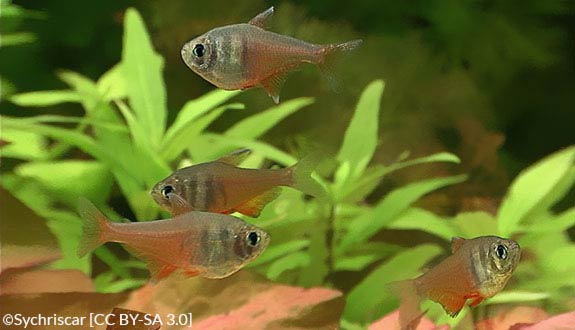
You will absolutely have to maintain a small troop of at least 10 spruce grouse. Indeed, these gregarious fish absolutely need the presence of their congeners to feel good. But if your volume allows it, don't limit yourself to 10 and form a larger group! The more they will be numerous, the more you will be amazed by their magnificent coloration.
This grouse is a good candidate for the community aquarium. Indeed, it does not care much about the other occupants of the tank. However, avoid cohabitation with large fish and with dynamic or overly lively fish that may stress them. They will easily cohabit with the other grouse in their family (in aquariums of adequate volume) as well as with all peaceful species compatible with their environment.
Breeding
How to breed the Flame tetra?
Breeding
How to breed the Flame tetra?
The reproduction of the Rio grouse is quite possible. Indeed, sexually mature and holy fish will almost always be ready to reproduce.
You will have to prepare a breeding tank of about thirty liters including:
- peat filtration
- thick carpet of java foam
- floating plants
- water parameters: hardness at 10°dGH, pH at 6.5, temperature at 24°C (75°F)
Introduce a couple or a small group into this aquarium. Usually spawning takes place in the late afternoon or evening.
200 to 300 eggs will be laid among the plants. They are very small, transparent and adhesive. After spawning, remove the parents and immerse the aquarium in complete darkness. The eggs are lucifugal, i.e. they are afraid of light.
Incubation lasts from 48 to 72 hours depending on the water temperature. When the fry start swimming (about 5 days after hatching), they are particularly fearful and hide. As they grow, bring light into their environment very slowly.
Feeding the fry: infusing then nauplias of artemia or cyclopses.
Its aquarium
Which aquarium for the Flame tetra?
Its aquarium
Which aquarium for the Flame tetra?
In its natural environment, it is usually found in slow-moving, slow-flowing streams. To offer it a suitable aquarium, you can go to a typical Amazonian biotope tank.
For decoration, the Rio grouse will be particularly sensitive to the presence of many reassuring plants, especially floating plants offering a safe shady cover. Also install peat bog roots for more naturalness (they are also very appreciated). To bring out its beautiful colouring, opt for a dark substrate. Finally, complete with tree leaves or alder fruit littering the ground.
The fish will be more at ease in slightly acidic and rather soft water (10°dGH is ideal). If possible, filter on peat to obtain a typical black water in its middle.
Good To know
Find all additional information!
Good To know
Find all additional information!
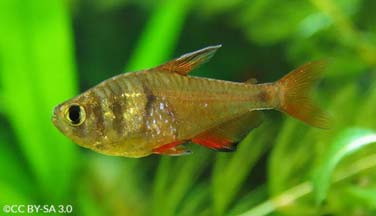
Despite their small size, they are excellent hunters!
It will be perfect to decorate richly planted aquascapes!
It will make a very good choice for beginners because it is easy to maintain and quite robust.
It can lose its colours if it is stressed. This is often the case during its arrival in a new aquarium, after a stressful transport. If he likes the aquarium, everything should quickly return to normal.
Even though it is abundant on the aquarium market, it seems that it has disappeared into its natural environment.
Yours photos!
Comments
Sort by:
Please login to post comments
